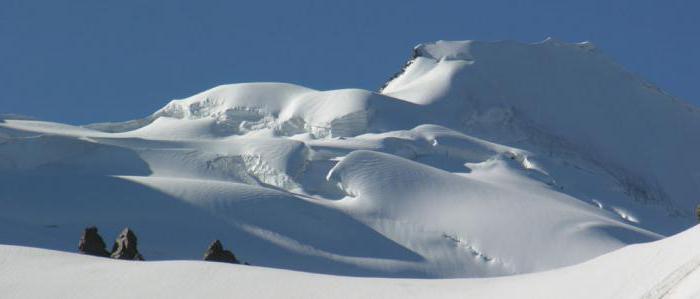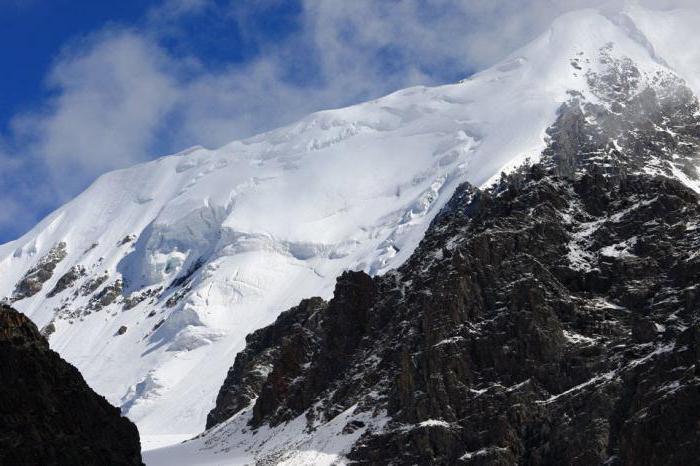Glaciers play an important role in replenishing all the rivers of the world. 16 million square meters km - such is their total area, it is about 11% of all land. They contain huge reserves of fresh water. In Russia, there are a huge number of them, with an area of about 60 thousand square meters. km Glaciers of Russia are divided into two types, according to the method of their formation:
- Coverslips. This is the vast majority of all glacial systems in the country. These include the ice of Franz Josef Land, Novaya Zemlya, Severnaya Zemlya and other islands of the Arctic. The average thickness on the islands in the Arctic Ocean is from 100 to 300 meters. They store huge reserves of fresh water.
- Mountain glaciers of Russia. Their share in the total area is only 5%. These are glacial accumulations of the mountain ranges of the Caucasus, the Urals, and Kamchatka. For their formation, it is necessary that two conditions are met: negative air temperatures and a large amount of precipitation. Often, if it rains often in the mountains, then they are accompanied by warm weather.
Variety of glaciers
There are a lot of classifications of glaciers, including mountain ones. What kinds of them can be found in our country?
- Snow spots. Snow accumulation in gentle valleys and slopes.
- Glaciers of steep slopes. Snow mass is collected at the shadowy foot of the mountain and feeds on avalanches.
- Hanging glaciers. They are located on steep slopes, as if hanging over it. They are small in size, but pose a danger, as they can fall down.
- Kar glaciers. Snow masses in arm-shaped valleys, with a steep rear wall.
- Glaciers of volcanic peaks. Occupy the tops of the mountains.
- Glacier glaciers. They have a common beginning - the top of the ridge, but the rates are in opposite directions from it.
- Norwegian type. This type of glacier is transitional from mountain to cover. Ice caps of plateau-like peaks spreads down. Having reached the edge, they go down in separate foci.
- Dales are located in mountain valleys.
Mountain glaciers of Russia do not remain the same in area. Some are contracting, others are increasing, and there are those that change their location as they move. What are the largest glaciers in Russia? The list of the 5 largest mountain systems with perennial ice is as follows.
Caucasus
This is the largest accumulation center of mountain glaciers. In the Russian part of the Caucasus Range, i.e. on its northern slope, huge masses are concentrated, with a total area of 1400 sq km. These are more than 2000 glaciers. Basically they are small in size, up to 1 square. km in diameter. The largest glacier in Russia is the Elbrus mountain complex in Kabardino-Balkaria, with an area of over 120 square meters. km Another major snow peak in the Caucasus is the peak of the extinct volcano Kazbek. It is here that more than 60% of all the ice of the Caucasus is concentrated. A feature is their alpine character. The Russian part of the snowy peaks of the Greater Caucasus is located on its northern slope, it is smoother and longer, in contrast to the South. There are more than 70% of the ice of the Greater Caucasus. The southern slope is steep and steep, with 30% of the Caucasus Mountains snows on it. The glaciation of this ridge is of great importance for feeding the rivers that originate here. These are tributaries of the Kuban River - Belaya, Zelenchuk, Laba - and the Terek River - Ardon, Urukh, Baksan. The glaciers of the Caucasus Mountains are retreating and their area is shrinking. Although this decrease is negligible, river nutrition suffers from it. Over a century, the level of the snow line has risen by 70-75 cm. Sometimes, a short-term onset of ice is observed in some areas.

Altai
In second place in the list of the largest mountain glaciers in the country are the snow of Altai. Here, in the south of Siberia, there are about 1,500 outbreaks that occupy an area of more than 900 square meters. km The largest glaciations on the Katunsky, South Chuy and Severo-Chuy ranges. Large masses are concentrated on Mount Belukha, where the great Altai river Katun and its tributaries begin. These places have become the most beloved and popular among climbers throughout Altai. Here is the Akkem glacier. Some believe that he has a special energy, and charges her his visitors. Another snowy peak of Altai is Aktru. The mountain is famous for the colossal temperature difference. In the summer there is unbearable heat, and in winter - severe cold. For this, Aktru is considered a local point of cold. The temperature here drops to minus 62º. But even despite such difficult climatic conditions, there are a lot of people who want to see these glaciers in Russia. Pictures of their landscapes are simply mesmerizing.

Kamchatka
The modern glaciation of the peninsula is significant. Snow masses are larger than in the Caucasus. They count about 450, with a total area of over 900 square meters. km Their main focus is on the Sredinny ridge and Klyuchevskoy group. The glaciers of Russia in Kamchatka have an interesting feature. They are referred to as the so-called caldera ones, due to the way they are formed. They are formed in the calderas and craters of volcanoes and hills, of which there are a huge number on the peninsula. In Kamchatka, the warm season is short, and the snow that falls on the tops of the hills does not have time to melt. Another feature of the Kamchatka snows is their low location. Glaciers descend from the peaks to a height of 1600 meters. Volcanic eruptions are of great importance in the life of snows. During the eruption, glaciers actively melt and fill the rivers with meltwater.
Koryak ridge
It is also called the Koryak Highlands. Located in the Far East, captures the Chukotka Autonomous Okrug and the Kamchatka Territory. The total number of glaciers here is 1330, and their area is more than 250 square meters. km The Koryak upland consists of short ridges and ridges that stretch from the northeast to the southwest. Russia's glaciers in the Far East are elongated, up to 4 km long. They are located very low, much lower than the snow line, at the level of 700-1000 meters. This is due to climatic conditions and the proximity of the cold sea. Another glacier in Russia - Mount Ledyanaya - its highest point is at the level of 2562 meters.
Mountains of Suntar Hayat
These Russian glaciers are located in Yakutia and the Khabarovsk Territory. There are 208 of them, with a total area of over 200 sq km. The ridge stretches for 450 km, and its highest point - Mount Cape Haya - at the level of almost 3,000 meters. In addition to mountain glaciers, there are about 800 square meters. km tyrynov. This is the name of the large perennial ice that forms when groundwater freezes.
The thickness of such ice is usually about 8 meters. Suntar-Khayat is a watershed of such large rivers of Siberia as Indigirka, Aldan, and the rivers of the Okhotsk Sea basin.